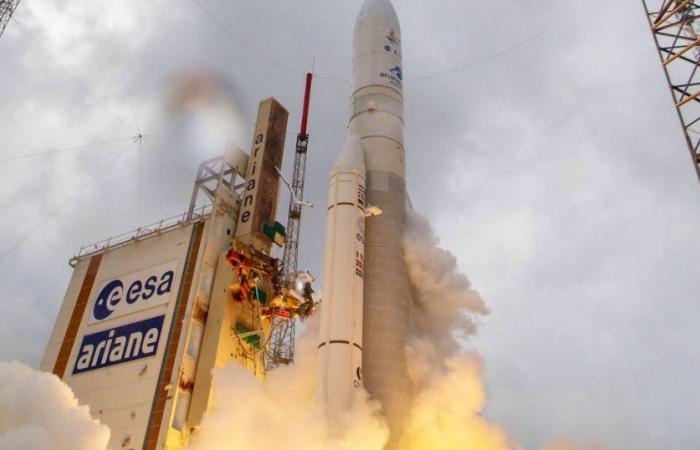The Ariane 6 rocket, which is due to make its maiden flight on July 9 from Kourou, is the heir to a long history of European launchers, which, like any good saga, has its ups and downs.
imago images/UPI Photo
A Christmas Eve 1979
The first born of the line is logically called Ariane 1. It is 2:13 p.m. on December 24, 1979 when the rocket takes off from the Kourou launch pad in French Guiana for the very first time. Initiated by French President Georges Pompidou ten years earlier, the road was long before this historic Christmas Eve for European space.
In the early 1970s, the Americans and the Soviets jealously shared access to space. Europe, which was trying to recover from the failure of its Europa launcher project in the 1960s, watched as a spectator to the satellite launches and the moon landings of Luna 9 and the Apollo spacecraft.
Last push
It was under the impetus – and with 60% funding – of France, with its experience with its Diamant rocket, that the Ariane program was adopted in 1973 in Brussels. A name in reference to the mythological story according to which the thread given by Ariadne allowed the hero Theseus to escape from the labyrinth. But despite the creation in 1975 of the ESA (European Space Agency), doubts remained.
The final boost to the program would come involuntarily from across the Atlantic: the United States agreed to place the Franco-German telecommunications satellite Symphonie into orbit, but on one condition: no commercial use. Independent access to space became a necessity for Europe, as did the Ariane program.
In the Atlantic
On December 15, 1979, a first takeoff attempt failed, but nine days later, Ariane 1 and its 47.4 meters of technology took off. The following year, Arianespace was created to commercialize its flights. Ariane 2, Ariane 3 and Ariane 4, more powerful, succeeded the pioneering rocket and made their first flights in 1986, 1984 and 1988 respectively.
Despite some failures, including that of Ariane 3, which ended up in the Atlantic in 1985 under the eyes of President François Mitterrand, the European launcher established itself on the market.
To cope with the increase in the mass of satellites, the Ariane 5 programme was voted on in 1987 at the European Council in The Hague and the launcher was completely overhauled.
From Rosetta to Juice
The new Ariane exploded after takeoff on its maiden flight in 1996 and joined its predecessor in the ocean in 2002, but then went on to achieve 82 consecutive successes and became Kourou’s flagship rocket.
She will accumulate 27 years of career, 117 flights and prestigious passengers like the Rosetta probe in 2004 which released Philae on the comet “Tchouri”. Or the James Webb telescope in 2021, a jewel of NASA which has continued to dazzle astronomers since then and in 2023, the Juice probe, still on its way to Jupiter.
Rapidly becoming the leader in the commercial satellite market – the other States with access to space then focusing on their national needs – Ariane 5 then suffered from the rise of the American SpaceX.
Elon Musk et Falcon 9
As early as 2015, it launched more Falcon-9s than Ariane 5s and in 2023, the year the European launcher is retired, Elon Musk’s company will crush the global market with 96 launches of its large launcher (compared to two for Ariane 5). New competitors, such as China and India, have also entered the scene.
The Europeans hope to regain autonomous access to space and relaunch the saga of 261 flights with the inaugural flight of Ariane 6, scheduled for July 9.






